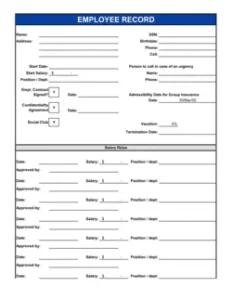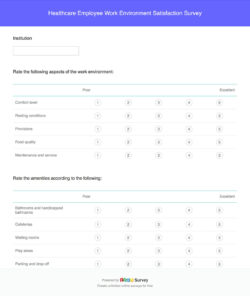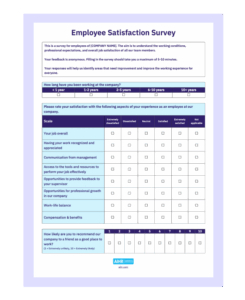In today’s dynamic workplace, the role of Human Resources extends far beyond traditional administrative tasks. HR departments are now strategic partners, crucial to fostering a positive employee experience and ensuring a healthy organizational culture. Just like any service provider, HR needs to understand if its offerings truly meet the needs and expectations of its “customers” – the employees. This understanding is paramount for continuous improvement and for HR to deliver maximum value to the entire company.
Collecting feedback from employees about their interactions with HR is not just good practice, it’s essential for refining processes, enhancing services, and ultimately, building a more engaged workforce. This is where a well-crafted hr customer satisfaction survey template becomes an invaluable tool, allowing you to systematically gather insights and identify areas of strength and opportunities for growth within your HR functions.
Understanding the Crucial Role of HR Satisfaction
The impact of a highly satisfied internal customer base when it comes to HR services cannot be overstated. When employees feel supported, understood, and efficiently served by their HR department, it translates into higher morale, increased productivity, and reduced turnover. Think about it: if an employee struggles with a benefits query, an onboarding issue, or a payroll discrepancy, and finds HR difficult to reach or unhelpful, their frustration doesn’t just stop at that interaction. It can ripple through their entire day, affecting their work quality and their perception of the company as a whole. Conversely, positive HR interactions can significantly enhance an employee’s overall experience and commitment to the organization.
Therefore, measuring HR satisfaction isn’t just about ticking a box; it’s about proactively addressing potential friction points before they escalate and leveraging successes to build a truly employee-centric environment. Regular feedback loops allow HR to be agile, responsive, and always aligned with the evolving needs of the workforce. It transforms HR from a reactive department into a proactive strategic asset that genuinely contributes to business success.
Key Areas to Cover in Your HR Survey
To get a comprehensive picture of HR satisfaction, your survey needs to touch upon various touchpoints and service areas. Here are some critical aspects you should consider including:
- Onboarding Process: How smooth and informative was the initial integration into the company?
- Payroll and Compensation: Accuracy, timeliness, and clarity of paychecks and compensation information.
- Benefits Administration: Ease of understanding and accessing health insurance, retirement plans, and other perks.
- Employee Relations and Support: Responsiveness and fairness in handling employee grievances or inquiries.
- Learning and Development: Quality and relevance of training programs and career development opportunities.
- Performance Management: Clarity, fairness, and effectiveness of performance reviews and feedback.
- HR Communication: How effectively and clearly HR communicates policies, updates, and important information.
- Overall HR Professionalism: Perceived helpfulness, friendliness, and expertise of HR staff.
By covering these diverse areas, you’ll gain specific, actionable insights into where HR is excelling and where improvements are most needed. This detailed feedback allows for targeted interventions, ensuring that your efforts to enhance satisfaction are both efficient and effective.
Crafting Your Effective HR Customer Satisfaction Survey
Building a survey that truly resonates and extracts meaningful feedback requires more than just a list of questions. It’s about thoughtful design, clear language, and a commitment to action. Start by defining the specific goals for your survey. Are you looking to gauge overall satisfaction, or drill down into a particular HR service, like a new benefits enrollment system? Clear objectives will guide your question selection and survey structure, preventing it from becoming a general, unfocused questionnaire. Remember, brevity and clarity are your friends; employees are more likely to complete a concise, easy-to-understand survey.
When formulating questions, use a mix of question types to gather both quantitative and qualitative data. Likert scales (e.g., “Strongly Disagree” to “Strongly Agree”) are excellent for measurable satisfaction levels, while open-ended questions provide invaluable context and suggestions for improvement. Encourage honest feedback by assuring anonymity and highlighting that the survey is for genuine improvement, not performance assessment. Make sure the language is straightforward and free of HR jargon, ensuring everyone understands what’s being asked.
Once your survey is ready, consider the best way to distribute it to ensure maximum participation. Email links, internal communication platforms, or even QR codes in common areas can all be effective. Follow up with reminders, but avoid overwhelming employees. The goal is to make participation as convenient as possible. After the data is collected, the real work begins: analysis. Look for trends, common themes in open-ended responses, and significant deviations from expected satisfaction levels. Prioritize areas that show the lowest satisfaction or are identified as most critical by employees.
Finally, and perhaps most importantly, act on the feedback you receive. There’s little point in collecting data if it just sits gathering digital dust. Communicate the key findings back to employees, highlighting what HR has learned and, more crucially, what actions will be taken as a direct result of their input. This transparency builds trust and demonstrates that their voices truly matter, encouraging even greater participation in future surveys. Implementing improvements based on this feedback not only enhances HR services but also reinforces a culture where employee voices are heard and valued, ultimately contributing to a thriving workplace.
Implementing a robust feedback mechanism through a carefully designed survey template is a powerful way for your HR department to demonstrate its commitment to serving employees and continuously improving. It transforms abstract goals into measurable outcomes, driving tangible enhancements in the employee experience.
By consistently gathering and acting upon employee insights, your HR team can evolve into an even more effective, responsive, and valued resource for everyone in the organization, fostering an environment where every employee feels supported and engaged.



